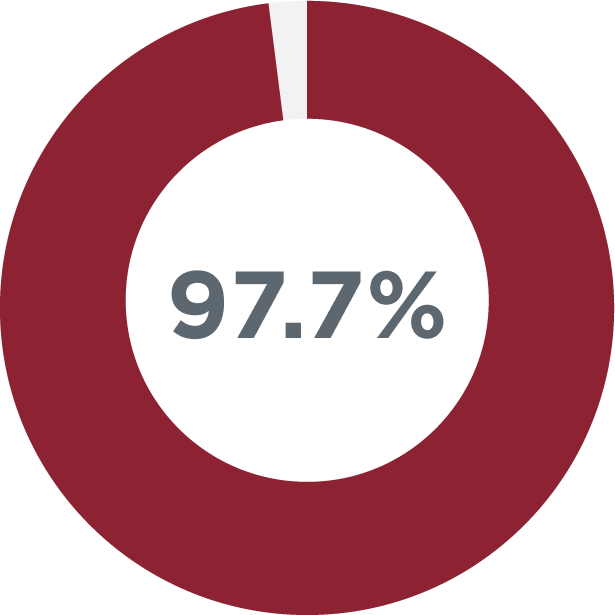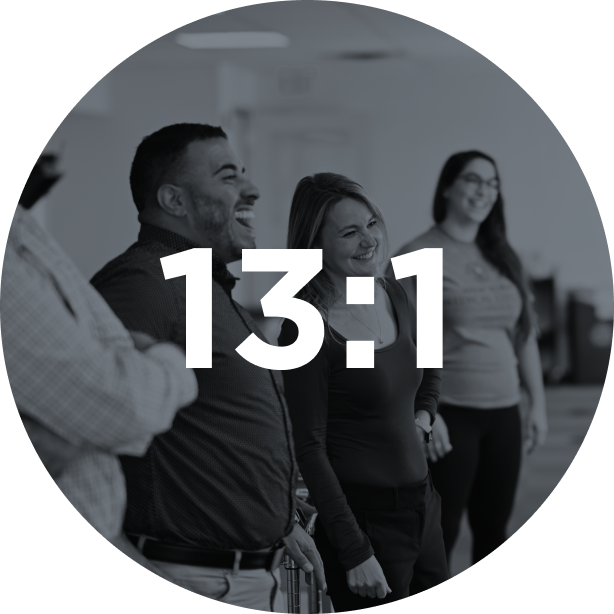
Doctor of Physical Therapy (D.P.T.)
Do you want to promote performance and function, optimize movement, and alleviate pain in individuals of all ages? Do you want to learn how to deliver targeted exercises, manual therapy techniques, and patient education, to help people recover from injuries, surgeries, or illnesses that affect their ability to move and perform daily activities? If so, you’ve come to the right place!
The Doctor of Physical Therapy program at New York Medical College is a three-year, full-time, in-person and on-campus program that will help you evolve into a competent, caring health professional. We promote student engagement, as is evidenced by our use of interactive, case-based learning, simulation center activities, and clinic visits during didactic courses.
You’ll learn how to examine, evaluate, diagnose and treat patients and clients across the healthspan and lifespan, and to craft individualized plans to address underlying physical or lifestyle challenges. As a core feature of your physical therapy education, you’ll complete four full-time clinical education experiences. These will take place at our affiliated local and national hospitals, outpatient clinics and other health care facilities.
Here are just a few of the benefits that come with our physical therapy program:
- Access to the expert faculty and advanced facilities that come with a medical school campus
- 24-hour access to a human anatomy lab and clinical labs
- An intellectually rich environment—program faculty and students may conduct research together, treat patients and provide community service to underserved members of society
- Clinical coursework at Westchester Medical Center, Burke Rehabilitation Hospital and many other major local clinics
Quick Facts

97.7% Licensure Pass Rate

100% 2-Year Average Employment Rate

13:1 Student to Lab Instructor Ratio
Learn What Sets Our Physical Therapy Program Apart
[upbeat music]
[White Background; Black Logo with Maroon Seal, “New York Medical College, A Member of the Touro College and University System”; Maroon Logo, “School of Health Sciences and Practice, and Institute of Public Health”;
Black Lettering, “Department of Physical Therapy”]
[music continues]
[Image: Sunshine Cottage, New York Medical College campus, Valhalla New York]
[Image: left, lamppost banner for New York Medical College; centered, a concrete architrave with an image of an owl surrounded by eight stars; and right, a white column with Fluting and Fillets]
NARRATOR: Here at New York Medical College
[Image: auditorium with students listening to a lecture, while viewing a projected image of an ivory bas-relief with the caption “Vanitas skeleton tomb scene”]
NARRATOR: we have a three-year Doctor of Physical Therapy Program.
[Image: three Physical Therapy students practicing on volunteers, lying down on tables, showing them how to stretch the back muscles of the leg, with green stretching straps]
[speaking: Jerret, School of Health Sciences and Practice, Doctor of Physical Therapy Class of 2020]
JERRET: I really love the small class size here at New York Medical College.
[Video: of a physical therapy student, sitting on a red floor mat with a volunteer patient, holding a doll]
JERRET: We not only get to learn from the physical therapy faculty, we also get to learn from the doctors and professors from the other programs here at New York Medical College.
[Video: professor from the School of Medicine, lecturing]
[Video: physical therapy student practicing forward range of motion on the leg of a volunteer patient]
[speaking: Robert W. Amler, M.D., M.B.A., Dean, School of Health Sciences and Practice; and Vice President for Government Affairs]
AMLER: The physical therapy curriculum trains them not just in muscles and bones, but also trains in
[Image: group of students sitting around a physical therapy lab classroom, some seated on green tables, some on a red floor mat, and some standing; while an instructor in a blue shirt and khaki pants talks while gesturing with his hands]
AMLER: neuroscience, in respiratory physiology, in cardiac rehabilitation.
[Image: stock photo of a female physician in a white coat, wearing eyeglasses, looking over a document held by another woman wearing blue scrubs]
NARRATOR: Faculty come from the School of Medicine,
[Image: one female and one male laboratory technician, wearing white coats and blue gloves, moving clear samples into a blue plastic test tube rack]
NARRATOR: Basic Medical Sciences.
[Video: Professor, standing in class, taking the hand of a student, and pointing to the anatomy of the hand and wrist while speaking inaudibly]
NARRATOR: We have over 26/27 part-time clinical faculty bringing their clinical expertise to the program.
[speaking: Jerret, School of Health Sciences and Practice, Doctor of Physical Therapy Class of 2020]
JERRET: We're given 24-hour access to the anatomy lab,
[Image: female student with dark hair wearing blue scrubs, looking at a spine model]
JERRET: where we have our own cadavers that we dissect throughout the course.
[Image: group of four students in blue scrubs wearing exam gloves, standing around a dissection, with an instructor in a white coat and eye-glasses present]
JERRET: Not a lot of other physical therapy programs have this, so it was a huge draw for me.
[Image: of two male students in blue scrubs with eyeglasses, looking over a book titled “Color Atlas of Anatomy”]
NARRATOR: We have a problem-based learning model,
[Image: Assistant Professor of Clinical Physical Therapy, stands in front of a smartboard, lecturing; gesturing, with arms at a ninety degree angle and palms facing each other]
NARRATOR: where students are learning to apply information in a mock clinical scenario.
[Video: group of students standing in a classroom, gathered around a female student in a white tee-shirt talking inaudibly while gesturing with her hand; pointing up, palm up]
[speaking: Jerret, Doctor of Physical Therapy Class of 2020]
JERRET: We're presented with cases, and provide interventions and examination strategies.
[Video: physical therapy student practicing range of motion on the right shoulder of a volunteer patient]
JERRET: I can't imagine another way to learn how to do physical therapy.
[Image: woman smiling, wearing a grey shift dress with a blue stethoscope around her neck]
NARRATOR: We have a strong emphasis on interprofessional education,
[Image: a young girl with her hair in a ponytail, holding a mirror, while pointing to her two front teeth]
NARRATOR: but we have speech pathologists
[Image: of a young female student in a blue and white striped shirt, holding a round blue Classic Farmer Says See 'n Say toy]
NARRATOR: and physical therapists
[Image: group of male and female students sitting on a red floor mat around a baby doll, practicing turning the doll’s head]
NARRATOR: and physicians and scientists learning together.
[Image: three lab techs in white coats, performing various experiments]
NARRATOR: It's about giving you an environment
[Image: of wheelchair racers, and guides, most wearing neon yellow, smiling, high fiving, and thumbs up]
NARRATOR: where you cannot help but to learn.
[Image: woman with short blonde hair, wearing a blue tee-shirt, holds her arms out in front of her gripping a red therapy band, while assisted by a physical therapy student in a red sweatshirt, which says “New York Medical College”]
[Black Background, bold white lettering, which reads, www.nymc.edu/dpt]
Physical Therapy That Goes Beyond Treating Illness & Injury
Accounting for socioeconomic determinants of health and addressing an individual's lifestyle and habits are just as important as treating their physical condition. Many factors influence health – genes, physical training, workplace injury prevention and stress regulation, to name a few. With the clinical, classroom and lab learning that comes with your NYMC Doctor of Physical Therapy training, you’ll have knowledge in all of the areas that impact the field.
With our focus on interprofessional education, learning from specialists in other disciplines is integrated into the D.P.T. program. We share the same campus as the NYMC School of Medicine, Graduate School of Biomedical Sciences and other SHSP programs and we all learn together – scientists, physicians, physical therapists, speech language pathologists and public health professionals. This powerful learning environment allows you to grow deeper in your own specialized field.
Physical Therapists collaborate with physicians, speech language pathologists and other health care professionals. On the NYMC campus, you’ll interact with aspiring and licensed physicians, speech language pathologists, and public health professionals and you’ll be well prepared to engage in interprofessional practice when it comes time to start your physical therapy practice.
“The faculty provides every opportunity for success and prepare you for future opportunities. As a student who lives on campus, I love getting to attend events hosted by NYMC clubs and utilizing the various study spaces the school offers.”
Savannah A., D.P.T. Class of 2026
D.P.T. Program & Admissions At a Glance
View our Application Requirements for more info. View our tuition and financial fact sheet for more info on tuition costs.
Physical Therapy Career Overview
Physical Therapists are in high-demand and with a 18% job growth rate, the field is growing much faster than average. With increased demand for P.T. specialists, a growing wellness trend and an aging population, physical therapists can look forward to strong job security.
What Is the Average Physical Therapist Salary?
The average salary for a physical therapist in New York is approximately $89,000 per year, while a sports therapist makes an average of $97,276. (salary.com) Although salary and demand vary by location, you should expect a stable job market and an above-average salary regardless of where you live in the country.
Where Do Physical Therapists Work?
Physical therapists can work in a variety of settings, including nursing homes, hospitals, sports facilities, as well as your own private practice. Regardless of setting, physical therapists have an active and physically demanding career. The role requires both strong clinical reasoning skills and anatomical knowledge, but also a strong sense of compassion and emotional intelligence.
Physical Therapist Licensure and Practice
Both a D.P.T. degree and professional licensure is required when entering the physical therapy field. After graduation, you’ll need to take the National Physical Therapy Exam administered by the FSBPT, to become a licensed physical therapist. Our graduates consistently have a 100% or near 100% passing rate. After graduation and licensure, you can continue with a fellowship, residency, or specialize further and pursue board certification.
D.P.T. / M.P.H. Joint Degree Option
At New York Medical College, we also offer a joint degree option that brings together the Doctor of Physical Therapy and Master of Public Health program. This specialized track allows you to gain mastery of two health care fields at once and prepares you to be a health care leader with wider career flexibility.
Learn more about our D.P.T. / M.P.H. option.
Featured Physical Therapy Stories
Class of 2027 D.P.T. Students Don White Coats for the First Time
Doctor of Physical Therapy Students Celebrate Transition to Clinical Education
Paul M. Spano, D.P.T. '18, PT, Restores the Dreams of Injured Athletes
An Ice Skating Accident Leads Dr. Spano to Sports Medicine and Rehabilitation
Justinian Michaels Aspires to Bring Athletes Back to the Game
Merging Athletic Training and Physical Therapy to Lead Athletes on the Frontlines of Recovery
CAPTE Accreditation
The Doctor of Physical Therapy program at New York Medical College is accredited by the Commission on Accreditation in Physical Therapy Education (CAPTE).
Commission on Accreditation in Physical Therapy Education
3030 Potomac Ave., Suite 100
Alexandria, VA 22305-3085
Telephone: (703) 706-3245
Email: accreditation@apta.org
Website: www.capteonline.org

